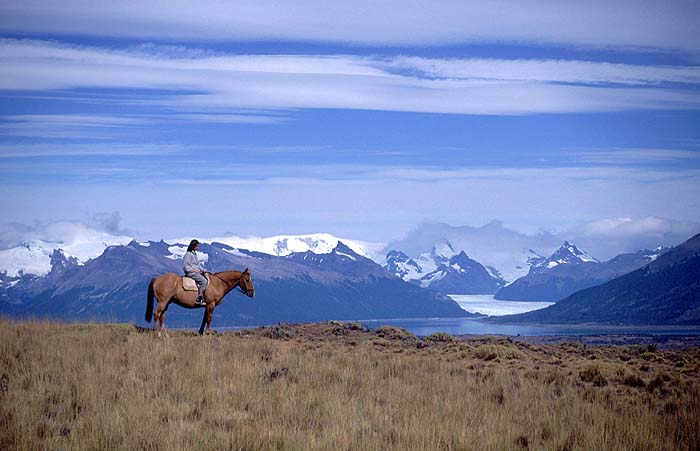High above the scouring winds that rush across the steppe, half-a-dozen condors drift on the thermals. The horses walk on, oblivious to the circling overhead, disturbing a grey fox cub which scurries off into deeper cover.
Hearing our approach, a startled hare kicks off through the grass. On the horizon, mountains stand like snowy cathedrals, illuminated by shafts of sunlight stealing through the clouds. A glacier slides snakelike down a valley. Below us is a turquoise lagoon decorated with pink flamingos, swans and upland geese.
Suddenly, just as I am wondering whether this isn't the perfect afternoon, horse-riding amid big Patagonian skies - they don't come any wider than this - with a private wildlife show thrown in, there comes a cry from Leslie. "Look, eagle!"We turn in time to see a dark shape swooping down through the clear sky. It is a plunging descent and only at the last moment do the talons come out like brakes to check it. Then there is a blur and in an instant the great bulging wings are rising skywards again with a reluctant trophy.
"It's a black-chested buzzard eagle," says Leslie. "And now it's got a hare for dinner."
Though none of us could conceivably be hungry - after only three days in Argentina I am beginning to turn into a steak - this observation apparently reminds us of our own stomachs, and within moments we are galloping back wildly across the plain, chasing our elderly gaucho guide with a stinging wind in our faces.
Home is the Alta Vista Hostería, a luxuriously converted farmstead run by Leslie Scovenna. Surrounded by slender cypresses and poplar windbreakers, it sits amid 185,355 acres (75,000 hectares) of scenery that makes the Scottish Highlands seem puny by comparison.
Sarah Ferguson, Duchess of York, stayed here several years ago and gave the place her royal seal of approval. "Walt Disney has been around your house with his colourful magical paintbrush," reads her entry in the guest book. "To be here is walking into a world of make-believe - totally overwhelming in its splendour."
It is definitely not the first thought that comes to mind as we sip the chilled pisco sours that await and discuss the collapse of Patagonia's traditional sheep-rearing economy and its replacement with tourism for the highly solvent.
The Estancia Anita, to which the hostería belongs, is the largest ranch in the region with more than 25,000 head of sheep. But it is now no more than a hobby for its owner, a supermarket tycoon who likes to maintain the old - and fast disappearing - Patagonian traditions. Over the years, the price of wool has declined sharply on the international market since the golden era of 1880-1920, and one by one the estancias have gone out of business.
No longer the solitary romantic figure hunting pumas and herding sheep in the mountains, even the gaucho, archetypal figure of the Patagonian landscape, has been forced to move with the times and evolved into a guide for inexpert riders such as myself. As for the cuisine, while beef is big in Buenos Aires, lamb, thankfully, remains a staple in Patagonia, as tender as an adolescent love letter.
Many visitors who come to these southern shores gravitate towards the Perito Moreno glacier, one of the highlights of the Los Glaciares National Park, 6,000 sq km of pristine wilderness, almost half of which is covered by giant ice fields along the border with Chile.
Argentines mutter darkly about how their neighbours have stolen the word Patagonia as a marketing ploy to boost their own tourist industry. Slightly unethical, perhaps, but you can see why the Chileans have done it.
A launch plies the waters of Lago Argentina, giving the best views of Perito Moreno's 60-metre (nearly 200ft) cliffs. This is one of the few places in the world where you can watch a glacier in action.
Every few minutes, slabs of packed snow the size of football pitches detach themselves and crash spectacularly into the lake below to oohs and aahs from a glamorous party of Argentines from Buenos Aires. The men, tanned and expensively dressed, look prosperous.
The women look lifted.
Heartier and less prosperous types who want to get among the mountains head to El Chaltén, a one-horse town founded in 1985 as a military outpost. It is now the capital of trekking in Argentina with its own microbrewery and chocolate house. The scenery, as you come to expect with all things Patagonian, is monstrously beautiful.
High above the town, loom the range of jagged peaks that attract some of the world's more audacious climbers, chief among them Mount Fitzroy (3,405 metres) and the impossibly vertical finger of granite Cerro Torre (3,102 metres). More vertically challenged hikers such as myself stick to one of the many long treks that offer magnificent views of Fitzroy. Descending from one, I bump into a middle-aged man from Buenos Aires.
"I've come to Patagonia to escape the financial crisis," he says cheerily, pointing to the sky. "To see things like this."
Overhead, a condor circles confidently in agreement.

